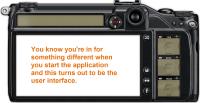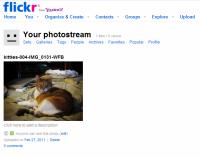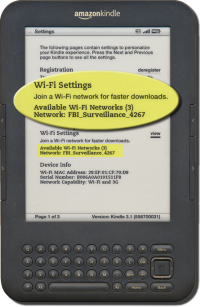I Never Thought I'd Like a Wingnut
Alien Skin Software has ministers of propaganda. Seriously. Or maybe not so seriously and that's seriously one of the reasons that I like the company. Now they have a Wingnut Division. Or maybe it's a studio. And Wingnut has a product called Lo-Fi. At a time when every other application is trying to help improve your digital photographs, Lo-Fi wants to make them worse. But by making them worse, it improves them. Rather like destroying something to save it.
Winston Churchill called the Soviet Union a riddle wrapped up in an enigma. Hold that thought for a moment.
Alien Skin ministers of propaganda Jeff Butterworth and Jimmy Beech say that Alien Skin "created a studio named Wingnut within Alien Skin Software to produce fun little consumer products. Wingnut's first product is Lo-Fi, a stand-alone app for the Mac and Windows desktop. Lo-Fi adds funky toy camera effects to JPEG photos and can easily share them on Flickr and Facebook. Lo-Fi doesn't have the pro features of our plug-ins, but it is perfect for regular folks who don't own Photoshop. Next time your friends bug you to jazz up their snapshots, just tell them to try Lo-Fi!"
Enigmatic? Yes. And with an intro like that, I had to check it out.
You can try Lo-Fi for free and, when you decide you want to buy it (as you probably will) you'll be out just $30.
Here are some important points:
- It's not a plug-in, so you don't need Photoshop or Paint Shop Pro or anything else.
- It works only on JPG images. So if you shoot fancy raw images (and you should) you'll have to convert them to JPG before feeding them to Lo-Fi.
- The interface is disgustingly simple. Any idiot could learn how to use it in less than 3 minutes. It took me only 10 to master it.
- It doesn't do a lot of things, but how much would you expect for $30.
- It's more fun to use than you would expect for something that costs less than dinner for two at a cheap restaurant.
The Making of a Lo-Fi Image
 The user interface (UI) is different. As you can see, it looks somewhat like the back of a digital camera. Because only 3 primary settings exist, this UI works well.
The user interface (UI) is different. As you can see, it looks somewhat like the back of a digital camera. Because only 3 primary settings exist, this UI works well.
 When you expand this image, you'll be able to read the labels that I've applied for the various controls.
When you expand this image, you'll be able to read the labels that I've applied for the various controls.
Click a small image for a larger view. Click the larger view to close it.
The icons on the right allow you to control the 3 primary settings: Film type, mood, and frame.
 I decided to start with this picture of Phoebe on the bed. This is the original JPEG.
I decided to start with this picture of Phoebe on the bed. This is the original JPEG.
 I liked "Oldachrome" as the film type.
I liked "Oldachrome" as the film type.
 Because Phoebe is the original glamour cat, the Glamour mood seemed appropriate.
Because Phoebe is the original glamour cat, the Glamour mood seemed appropriate.
 And for the frame I selected Vignette.
And for the frame I selected Vignette.
That's all there is to it. All I need to do is save the image (the application suggests adding "-Lo-Fi" to the file name so that the original won't be overwritten.)
 Now that I have an image, I can easily upload it to Facebook so that I can share it with friends.
Now that I have an image, I can easily upload it to Facebook so that I can share it with friends.
 And I can upload the image to Flickr.
And I can upload the image to Flickr.
 Because I've joined the Lo-Fi Flickr group, any images that I upload will automatically appear in that group ...
Because I've joined the Lo-Fi Flickr group, any images that I upload will automatically appear in that group ...
 ... as well as in my own photo stream.
... as well as in my own photo stream.
 Bottom Line: You won't find a way to have more fun for $30.
Bottom Line: You won't find a way to have more fun for $30.
Lo-Fi isn't a full-featured photo editing application. It's just a way to have fun with some of your images. It's not appropriate for every image, but even a $500 plug-in isn't appropriate for every image. The application is not about perfection. It's about fun. I can't give it a barrel of monkeys because I don't have any monkeys, but I can bestow a 5-cat rating.
For more information, visit the (Alien Skin) Lo-Fi website.
Broadcast: Fearing the Hulu Hoop
The networks are about to stage an end-run around local broadcasters. Since the beginning of commercial television, the networks have had to convince local stations to give their programs "clearance". Most of the time, they did. But not always. And broadcast television has been a real-time operation until recently when digital video recorders made time-shifting easy. Now there's Hulu.
 Hulu is a subscription service that offers ad-supported on-demand streaming video of TV shows, movies, trailers, clips, and made-for-the-Web videos. You might think that this is an operation that the networks would hate, but look at who's behind Hulu: ABC, NBC, Fox, many other networks and studios.
Hulu is a subscription service that offers ad-supported on-demand streaming video of TV shows, movies, trailers, clips, and made-for-the-Web videos. You might think that this is an operation that the networks would hate, but look at who's behind Hulu: ABC, NBC, Fox, many other networks and studios.
You'll notice that I didn't mention CBS. That's because CBS selected Netflix as its streaming-video partner.
Hulu videos available only in the United States and its territories. Hulu actually blocks many anonymous proxies.
Hulu uses the Flash Video format and provides Web syndication services for AOL, MSN, MySpace, Facebook, Yahoo, and Comcast's fancast.com.
Hulu's basic service provides standard definition programs for use on computers. A new "Plus" version offers high definition (790p) video. The basic service has the most recent 5 episodes of current programs and full-season catalogs of hundreds of programs.
The Plus version has all current-season episodes for 45 popular programs and every program from every season of 90 shows.
Both regular and Plus service offer some episodes from hundreds of programs.
The basic service is free (ad supported) and Plus costs $8 per month. That's a lot less than any cable television service. The ads are short but annoyingly frequent in the television clips. Less so for movies.
What's On?
Hulu has a huge movie library and a vast array of episodic TV shows. Many of the episodes are full length, but some are just short clips. Although some of the content is from programs that are still on the air, you'll find episodes from older shows that are no longer on TV. Some of these go back to the 1960s.
How Annoying Are the Ads?
As noted, the ads are short but frequent and the production isn't particularly good. On television, there's always a fade to black before the commercial break. Hulu doesn't do that and cutting directly to a commercial can be disconcerting.
There is no such thing as free television. If you don't pay with dollars, you pay by allowing the station, the network, or the service such as Hulu to rent your eyeballs to advertisers.
How Complicated is Hulu?
Hulu is easy to use. Screenshots represent videos that are then grouped into columns. There's so much content that this can be a bit overwhelming. But if you're looking for a specific show, you can search by name or you can also look at an alphabetical list of all the shows in Hulu’s library.
When you find something to watch, you'll like the Hulu video player because it uses Flash to run inside your browser. If you have a second monitor, you can drag the video over there and keep working on your main monitor. This is far better than having to install a proprietary video player.
 Bottom Line: Tired of your cable provider? Maybe Hulu is the answer.
Bottom Line: Tired of your cable provider? Maybe Hulu is the answer.
Cable providers (who also provide Internet service) must be worried that subscribers will drop their $40 per month (or more) cable television service and start watching television using Hulu. That would not be an unreasonable fear.
For more information, visit the Hulu website.
Making a War Driver or Piggybacker Nervous
"War drivers" log and collect information about the wireless access points (WAPs) they find while driving. These could include wireless access points provided by municipalities, those provided by restaurants and coffee shops, or even unintentionally free WAPs provided by home users who don't bother to protect their systems. War drivers aren't a problem but piggybackers might be. These are folks who would prefer to use your Wi-Fi than to pay for their own.
 I have to admit that I borrowed this idea, but that doesn't make it any less amusing. Imagine a war driver or a piggybacker scanning Wi-Fi SSIDs (SSID is "service set identifier") and finding "FBI_Surveillance_4267" (see the display on my Kindle at right). Depending on the software they're using to sniff for signals, they might see that the SSID is locked.
I have to admit that I borrowed this idea, but that doesn't make it any less amusing. Imagine a war driver or a piggybacker scanning Wi-Fi SSIDs (SSID is "service set identifier") and finding "FBI_Surveillance_4267" (see the display on my Kindle at right). Depending on the software they're using to sniff for signals, they might see that the SSID is locked.
Locked or not, would a piggybacker try to connect to an SSID called "FBI_Surveillance_4267"?
Think about that for a moment. If the FBI is in your neighborhood with a surveillance unit that needs a Wi-Fi connection, do you think they would call that Wi-Fi connection "FBI_Surveillance_4267" or something like "linksys", "2wire231", or "ABCS_Secure"? Those are all SSIDs that are visible from my home.
The FBI doesn't announce its presence and would be likely to use a common name rather than "FBI_anything" or "gJB9a3A3nUqcztn". If you're part of a surveillance team, your goal is to blend in.
But that doesn't make the joke any less funny if you're a geek with an odd sense of humor and access to the router!
Short Circuits
Hide Passwords in Plain Sight
Long, secure passwords can be hard to remember. Once you've logged on to a system, it's easy to use an application such as KeePass or (as I'll explain next week) a service such as LastPass. But what about the logon ID? Writing the password on a paper that's stuck to the monitor is a bad idea. And cleverly hiding it on a sticky note that's stuck to the bottom of the keyboard doesn't work very well, either. There's a way around this problem.
What if a sticky note on your monitor said 1987@ or Chrysler! or #Pittscat? Might observers think they have your password? Instead of passwords, these words are triggers. They can safely be written and displayed in the clear because nobody but you knows what they mean.
- 1987@ could remind you to use the address where you lived in 1987 followed by the "@" symbol. Let's say you lived at 57 Elm Lane, Springfield, Illinois in 1987. Possible passwords could be 57Elm@, 57ElmLane@, Elm57Lane@, 57ElmSpringfield@, Springfield57IL@, or any of several others. You'd need to remember only the address and the pattern.
- Chrysler! could be the address of the dealer where you bought your Chrysler automobile. Or it might be 405Lexington!, Lex@Fifth!, or LexAtFifthAve! (the location of the Chrysler Building in New York City.)
- #Pittscat might be the name of your favorite cat during the years you lived in Pittsburgh. If the cat's name was Phoebe but you often called her FeezleBee, your password would be #FeezleBee or #feezleBee or #FeEzLeBeE.
These are bits of information that are well known to you but not known to others. That's what makes it safe to hide them in plain sight.
Granny the Hacker
This is the kind of story that no editor would allow a mystery writer to include in a novel: An old woman in Georgia (the former Soviet republic, not Jimmy Carter's home state), scavenging for copper to sell as scrap, stuck her spade into the ground and cut a fiber optic cable. That immediately cut off most of Armenia and portions of Kazakhstan and Azerbaijan from the Internet.
Oops. The 75-year-old woman was arrested but then, because of her age, released.
Nearly all of Armenia's Internet service goes through Georgia and more than 3 million people were without Internet service for about 5 hours. The local media are calling the woman "the spade-hacker". Although police released her, the woman faces charges of "damaging property" and could go to prison for 3 years.
Monitoring circuits immediately detected the problem and a security team found the woman still at the scene of the crime. Or dig. There were no accomplices.
Has Your Address Been Compromised?
Here we go again. Another big attack and a bunch of e-mail addresses at risk. Maybe. I've received several messages this week saying that my address my be in the hands of bad guys. So what? My addresses receive hundreds of spams per day. If some bozo sends a few more, will I even notice.
- Chase Bank: "Chase is letting our customers know that we have been informed by Epsilon, a vendor we use to send e-mails, that an unauthorized person outside Epsilon accessed files that included e-mail addresses of some Chase customers. We have a team at Epsilon investigating and we are confident that the information that was retrieved included some Chase customer e-mail addresses, but did not include any customer account or financial information. Based on everything we know, your accounts and confidential information remain secure. As always, we are advising our customers of everything we know as we know it, and will keep you informed on what impact, if any, this will have on you."
- Crucial Memory: "On April 4, we were informed by Epsilon, a company we use to send emails to our customers, that files containing the names and/or email addresses of some Crucial customers were accessed by unauthorized entry into their computer system. We have been assured by Epsilon that the only information that may have been obtained was your name and/or email address. No other personally identifiable information that you have supplied to Crucial was at risk because such data is not contained in Epsilon's email system."
If you do any online banking or buy anything from online merchants, you may have received a similar message. This is certainly annoying but hardly worth spending any time worrying about.
Just keep in mind that we're still in the "Wild West" era of the Internet. There will always be criminals but security will continue to improve. Even so, it will never be perfect. Many companies use third parties to send messages for them. They provide the bare minimum of information to these providers. In most cases, just an e-mail address and possibly a name. With that information, about all a crook can do is send spam your way. And that's easy enough to deal with.


 The author's image: It's that photo over at the right. This explains why TechByter Worldwide was never on television, doesn't it?
The author's image: It's that photo over at the right. This explains why TechByter Worldwide was never on television, doesn't it?
